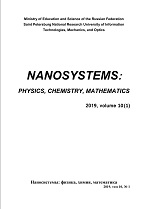|
This article is cited in 5 scientific papers (total in 5 papers)
CHEMISTRY AND MATERIAL SCIENCE
Hydrothermal synthesis of CeO$_{2}$ nanostructures and their electrochemical properties
A. N. Bugrovab, V. K. Vorobiova, M. P. Sokolovaa, G. P. Kopitsacd, S. A. Bolshakovb, M. A. Smirnova
a Institute of Macromolecular Compounds RAS, Bolshoy pr. 31, 199004 St. Petersburg, Russia
b St. Petersburg Electrotechnical University ”LETI“, ul. Professora Popova 5, 197376 St. Petersburg, Russia
c Grebenshchikov Institute of Silicate Chemistry RAS, Makarova emb. 2., letter B, 199034 St Petersburg, Russia
d St. Petersburg Nuclear Physics Institute, NRC KI, Orlova roscha mcr. 1, 188300 Gatchina, Leningrad region, Russia
Abstract:
Functional nanomaterials based on transition metal oxides are often used for the manufacture of supercapacitors and batteries, due to their special redox properties. The nanosized transition metal oxides used as the electrode material in some cases exhibit abnormally high values of capacitance and energy density. In this regard, it is important to understand what structural features of the nanomaterial determine the electrochemical characteristics of an electronic device. For this purpose, ceria nanorods and nanocubes were specifically synthesized under hydrothermal conditions at elevated pressure (15 MPa), different alkali contents, and two temperature regimes (100 and 180$^{\circ}$C). The obtained CeO nanostructures were characterized using the methods of X-ray diffraction, transmission electron microscopy, and low-temperature nitrogen adsorption. The electrochemical properties of ceria nanostructures were investigated in 1 M Na$_{2}$SO$_{4}$ water electrolyte. The influence of the structural and surface characteristics of the synthesized nanorods and nanocubes on their charge storage ability is discussed. It was shown that CeO$_{2}$ in the form of nanocubes demonstrate higher specific capacitance in comparison with nanorods, which makes them more attractive for application in supercapacitors with neutral electrolytes.
Keywords:
cerium dioxide, hydrothermal method, nanorods, nanocubes, fluorite structure, specific surface area, cyclic voltammetry, specific capacitance.
Received: 12.12.2019
Revised: 09.01.2020
Citation:
A. N. Bugrov, V. K. Vorobiov, M. P. Sokolova, G. P. Kopitsa, S. A. Bolshakov, M. A. Smirnov, “Hydrothermal synthesis of CeO$_{2}$ nanostructures and their electrochemical properties”, Nanosystems: Physics, Chemistry, Mathematics, 11:3 (2020), 355–364
Linking options:
https://www.mathnet.ru/eng/nano535 https://www.mathnet.ru/eng/nano/v11/i3/p355
|

|




 Contact us:
Contact us: Terms of Use
Terms of Use
 Registration to the website
Registration to the website Logotypes
Logotypes







 Citation in format
Citation in format 
